(Solved) Value Chain Concept - PDF
VerifiedAdded on 2021/02/20
|17
|4138
|37
AI Summary
Contribute Materials
Your contribution can guide someone’s learning journey. Share your
documents today.
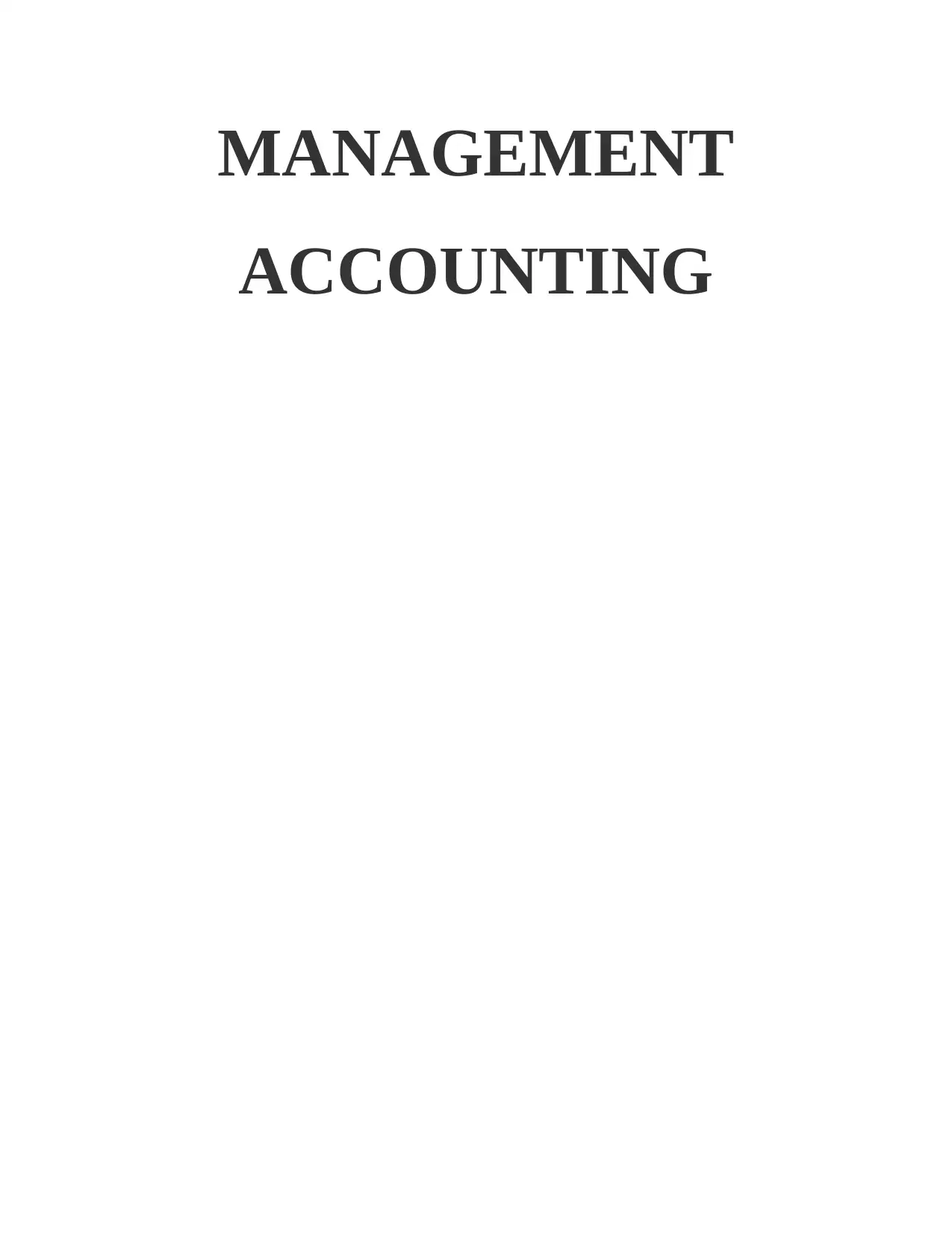
MANAGEMENT
ACCOUNTING
ACCOUNTING
Secure Best Marks with AI Grader
Need help grading? Try our AI Grader for instant feedback on your assignments.


Table of Contents
INTRODUCTION ..........................................................................................................................3
QUESTION 1 ..................................................................................................................................3
a.) Explantation of value chain concept and its benefits to organisations..............................3
b.) Evaluation of value chain concept in Reliance Worldwide Corporation Ltd...................4
QUESTION 2 ..................................................................................................................................7
a.) Estimated allocation rates for fixed and variable overheads for current period................7
b.) Total overhead cost allocated to the Job 20 in October....................................................8
c.) What is total cost of Job 20 ? ...........................................................................................9
d.) Amounts of fixed and variable overheads allocated to all jobs in October......................9
e.) Use of two costs pools instead of one and whether it would make any difference in bills of
clients when job includes more equipment and less labour than other jobs...........................9
QUESTION 3 ................................................................................................................................10
a.) Identifying cost pools and assigning costs to them ........................................................10
b.) Determining cost driver for each cost pool and explaining the reason for choice..........11
c) Calculation of allocation rates for each cost pool and cost driver ...................................13
CONCLUSION .............................................................................................................................13
REFERENCES .............................................................................................................................15
INTRODUCTION ..........................................................................................................................3
QUESTION 1 ..................................................................................................................................3
a.) Explantation of value chain concept and its benefits to organisations..............................3
b.) Evaluation of value chain concept in Reliance Worldwide Corporation Ltd...................4
QUESTION 2 ..................................................................................................................................7
a.) Estimated allocation rates for fixed and variable overheads for current period................7
b.) Total overhead cost allocated to the Job 20 in October....................................................8
c.) What is total cost of Job 20 ? ...........................................................................................9
d.) Amounts of fixed and variable overheads allocated to all jobs in October......................9
e.) Use of two costs pools instead of one and whether it would make any difference in bills of
clients when job includes more equipment and less labour than other jobs...........................9
QUESTION 3 ................................................................................................................................10
a.) Identifying cost pools and assigning costs to them ........................................................10
b.) Determining cost driver for each cost pool and explaining the reason for choice..........11
c) Calculation of allocation rates for each cost pool and cost driver ...................................13
CONCLUSION .............................................................................................................................13
REFERENCES .............................................................................................................................15
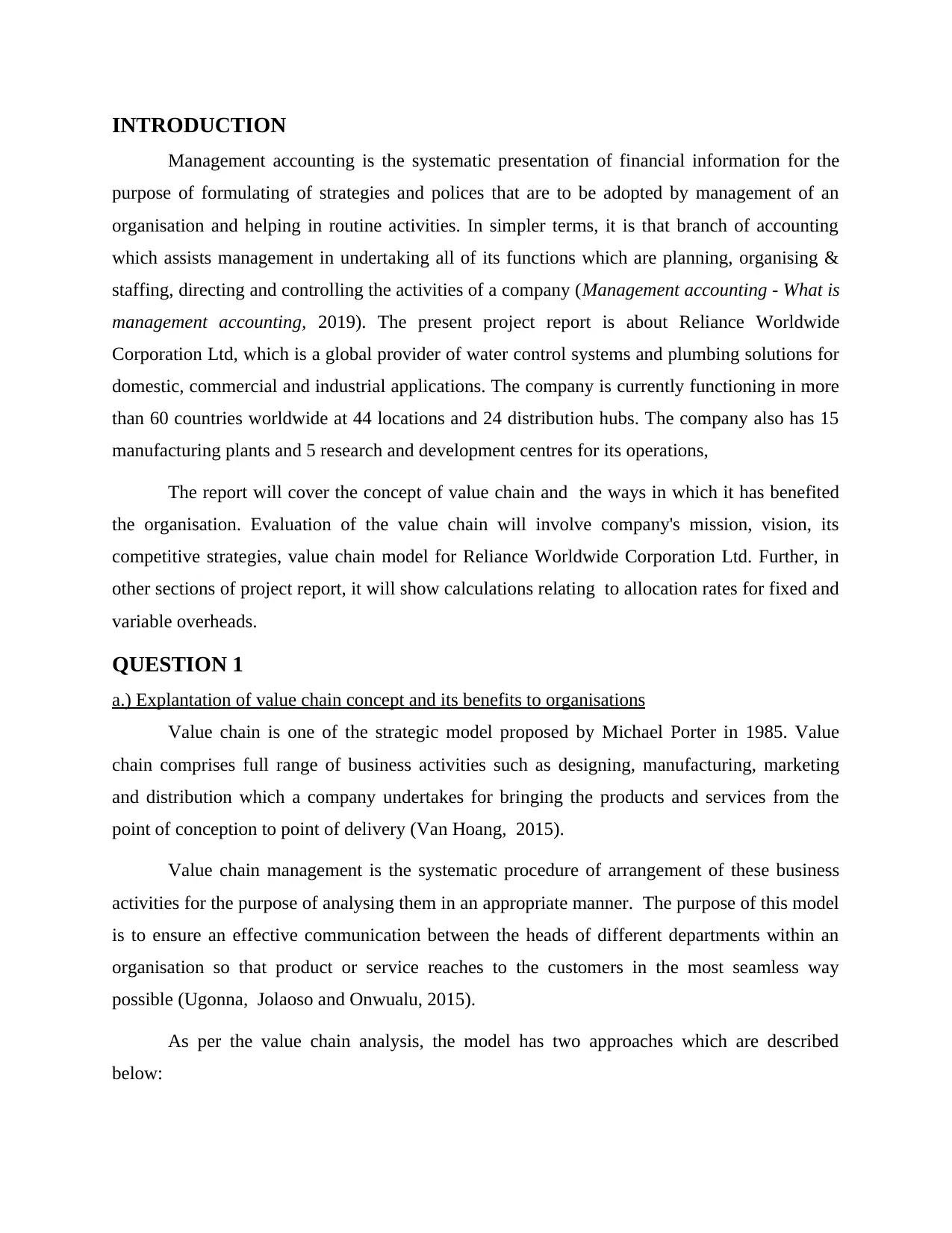
INTRODUCTION
Management accounting is the systematic presentation of financial information for the
purpose of formulating of strategies and polices that are to be adopted by management of an
organisation and helping in routine activities. In simpler terms, it is that branch of accounting
which assists management in undertaking all of its functions which are planning, organising &
staffing, directing and controlling the activities of a company (Management accounting - What is
management accounting, 2019). The present project report is about Reliance Worldwide
Corporation Ltd, which is a global provider of water control systems and plumbing solutions for
domestic, commercial and industrial applications. The company is currently functioning in more
than 60 countries worldwide at 44 locations and 24 distribution hubs. The company also has 15
manufacturing plants and 5 research and development centres for its operations,
The report will cover the concept of value chain and the ways in which it has benefited
the organisation. Evaluation of the value chain will involve company's mission, vision, its
competitive strategies, value chain model for Reliance Worldwide Corporation Ltd. Further, in
other sections of project report, it will show calculations relating to allocation rates for fixed and
variable overheads.
QUESTION 1
a.) Explantation of value chain concept and its benefits to organisations
Value chain is one of the strategic model proposed by Michael Porter in 1985. Value
chain comprises full range of business activities such as designing, manufacturing, marketing
and distribution which a company undertakes for bringing the products and services from the
point of conception to point of delivery (Van Hoang, 2015).
Value chain management is the systematic procedure of arrangement of these business
activities for the purpose of analysing them in an appropriate manner. The purpose of this model
is to ensure an effective communication between the heads of different departments within an
organisation so that product or service reaches to the customers in the most seamless way
possible (Ugonna, Jolaoso and Onwualu, 2015).
As per the value chain analysis, the model has two approaches which are described
below:
Management accounting is the systematic presentation of financial information for the
purpose of formulating of strategies and polices that are to be adopted by management of an
organisation and helping in routine activities. In simpler terms, it is that branch of accounting
which assists management in undertaking all of its functions which are planning, organising &
staffing, directing and controlling the activities of a company (Management accounting - What is
management accounting, 2019). The present project report is about Reliance Worldwide
Corporation Ltd, which is a global provider of water control systems and plumbing solutions for
domestic, commercial and industrial applications. The company is currently functioning in more
than 60 countries worldwide at 44 locations and 24 distribution hubs. The company also has 15
manufacturing plants and 5 research and development centres for its operations,
The report will cover the concept of value chain and the ways in which it has benefited
the organisation. Evaluation of the value chain will involve company's mission, vision, its
competitive strategies, value chain model for Reliance Worldwide Corporation Ltd. Further, in
other sections of project report, it will show calculations relating to allocation rates for fixed and
variable overheads.
QUESTION 1
a.) Explantation of value chain concept and its benefits to organisations
Value chain is one of the strategic model proposed by Michael Porter in 1985. Value
chain comprises full range of business activities such as designing, manufacturing, marketing
and distribution which a company undertakes for bringing the products and services from the
point of conception to point of delivery (Van Hoang, 2015).
Value chain management is the systematic procedure of arrangement of these business
activities for the purpose of analysing them in an appropriate manner. The purpose of this model
is to ensure an effective communication between the heads of different departments within an
organisation so that product or service reaches to the customers in the most seamless way
possible (Ugonna, Jolaoso and Onwualu, 2015).
As per the value chain analysis, the model has two approaches which are described
below:
Secure Best Marks with AI Grader
Need help grading? Try our AI Grader for instant feedback on your assignments.
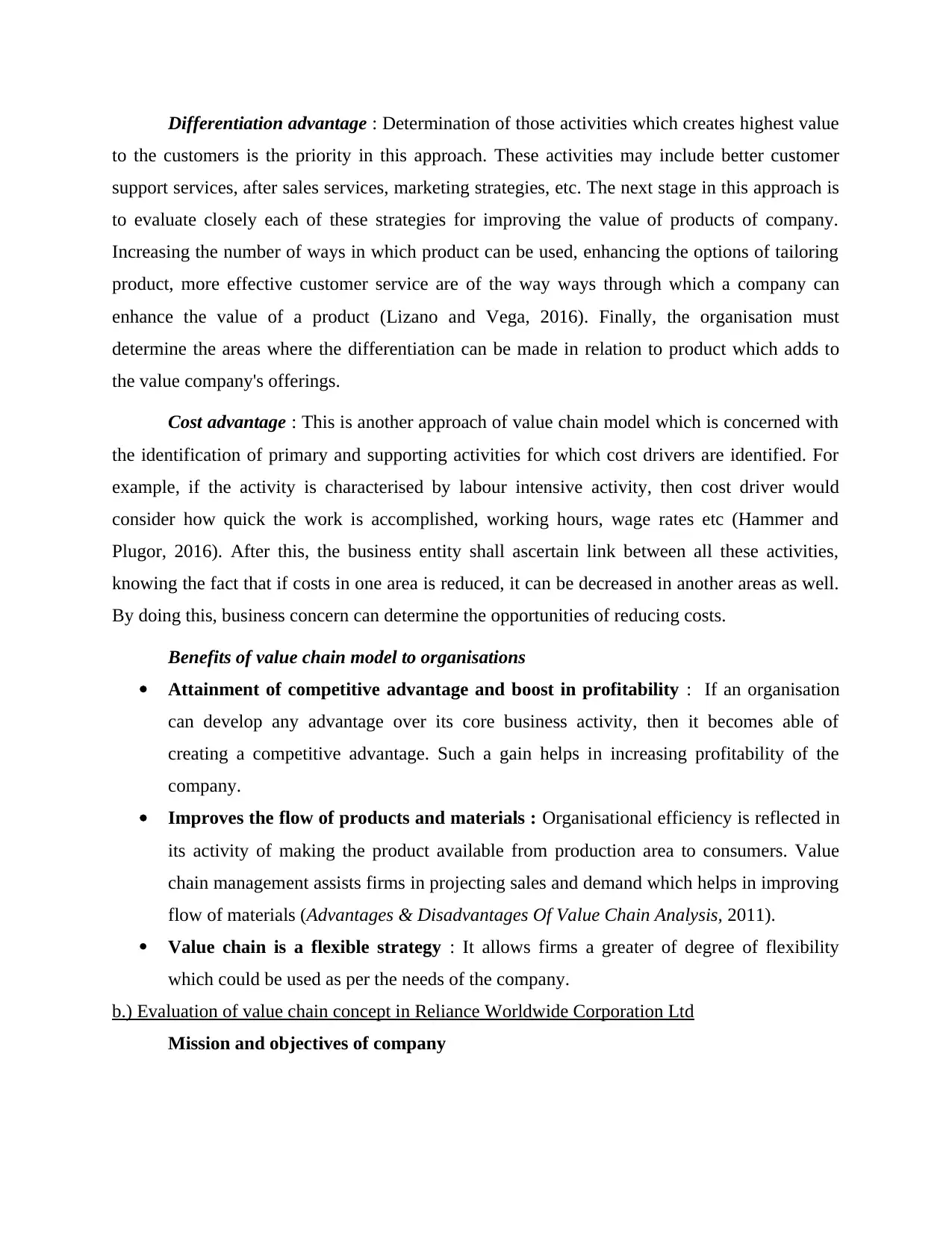
Differentiation advantage : Determination of those activities which creates highest value
to the customers is the priority in this approach. These activities may include better customer
support services, after sales services, marketing strategies, etc. The next stage in this approach is
to evaluate closely each of these strategies for improving the value of products of company.
Increasing the number of ways in which product can be used, enhancing the options of tailoring
product, more effective customer service are of the way ways through which a company can
enhance the value of a product (Lizano and Vega, 2016). Finally, the organisation must
determine the areas where the differentiation can be made in relation to product which adds to
the value company's offerings.
Cost advantage : This is another approach of value chain model which is concerned with
the identification of primary and supporting activities for which cost drivers are identified. For
example, if the activity is characterised by labour intensive activity, then cost driver would
consider how quick the work is accomplished, working hours, wage rates etc (Hammer and
Plugor, 2016). After this, the business entity shall ascertain link between all these activities,
knowing the fact that if costs in one area is reduced, it can be decreased in another areas as well.
By doing this, business concern can determine the opportunities of reducing costs.
Benefits of value chain model to organisations
Attainment of competitive advantage and boost in profitability : If an organisation
can develop any advantage over its core business activity, then it becomes able of
creating a competitive advantage. Such a gain helps in increasing profitability of the
company.
Improves the flow of products and materials : Organisational efficiency is reflected in
its activity of making the product available from production area to consumers. Value
chain management assists firms in projecting sales and demand which helps in improving
flow of materials (Advantages & Disadvantages Of Value Chain Analysis, 2011).
Value chain is a flexible strategy : It allows firms a greater of degree of flexibility
which could be used as per the needs of the company.
b.) Evaluation of value chain concept in Reliance Worldwide Corporation Ltd
Mission and objectives of company
to the customers is the priority in this approach. These activities may include better customer
support services, after sales services, marketing strategies, etc. The next stage in this approach is
to evaluate closely each of these strategies for improving the value of products of company.
Increasing the number of ways in which product can be used, enhancing the options of tailoring
product, more effective customer service are of the way ways through which a company can
enhance the value of a product (Lizano and Vega, 2016). Finally, the organisation must
determine the areas where the differentiation can be made in relation to product which adds to
the value company's offerings.
Cost advantage : This is another approach of value chain model which is concerned with
the identification of primary and supporting activities for which cost drivers are identified. For
example, if the activity is characterised by labour intensive activity, then cost driver would
consider how quick the work is accomplished, working hours, wage rates etc (Hammer and
Plugor, 2016). After this, the business entity shall ascertain link between all these activities,
knowing the fact that if costs in one area is reduced, it can be decreased in another areas as well.
By doing this, business concern can determine the opportunities of reducing costs.
Benefits of value chain model to organisations
Attainment of competitive advantage and boost in profitability : If an organisation
can develop any advantage over its core business activity, then it becomes able of
creating a competitive advantage. Such a gain helps in increasing profitability of the
company.
Improves the flow of products and materials : Organisational efficiency is reflected in
its activity of making the product available from production area to consumers. Value
chain management assists firms in projecting sales and demand which helps in improving
flow of materials (Advantages & Disadvantages Of Value Chain Analysis, 2011).
Value chain is a flexible strategy : It allows firms a greater of degree of flexibility
which could be used as per the needs of the company.
b.) Evaluation of value chain concept in Reliance Worldwide Corporation Ltd
Mission and objectives of company
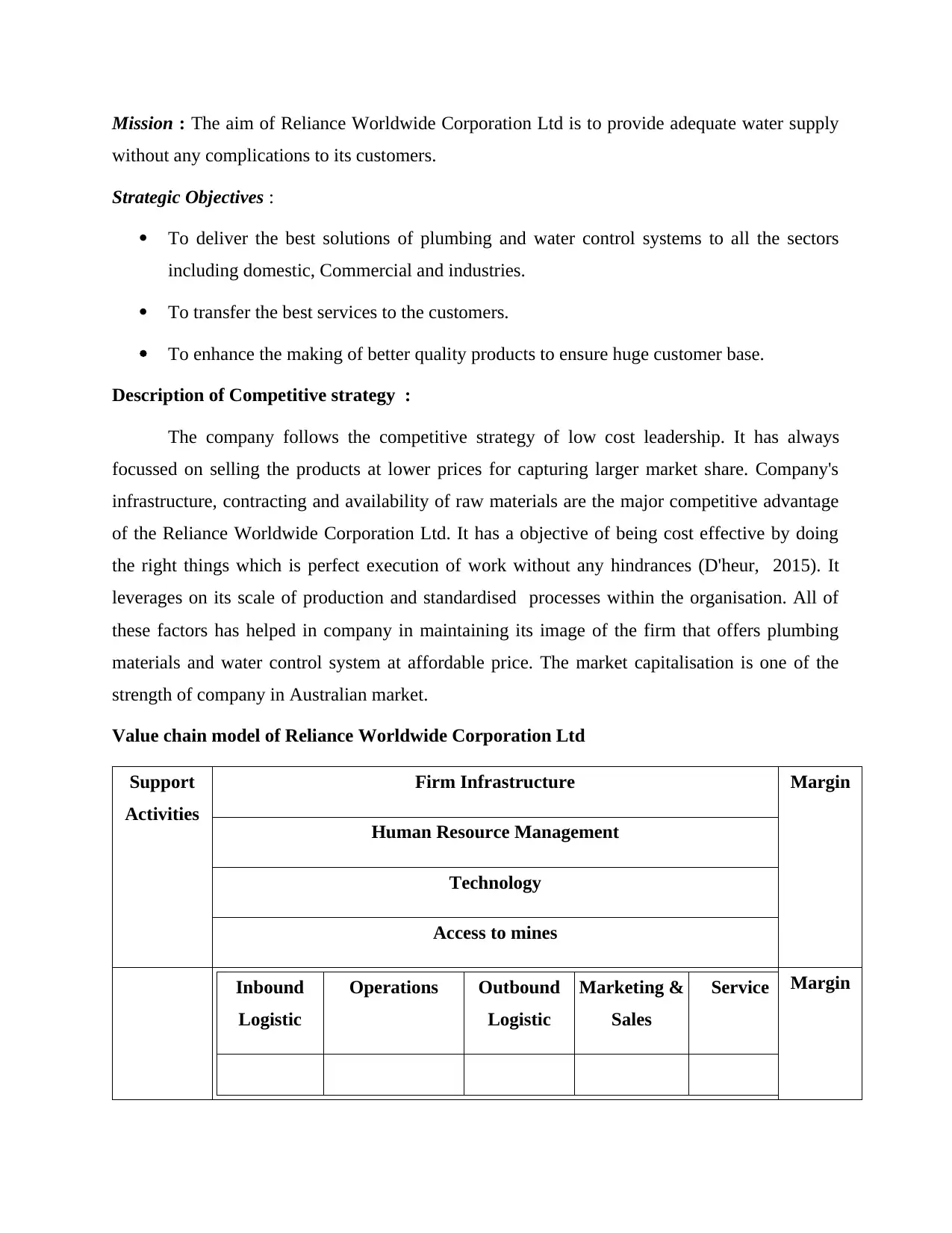
Mission : The aim of Reliance Worldwide Corporation Ltd is to provide adequate water supply
without any complications to its customers.
Strategic Objectives :
To deliver the best solutions of plumbing and water control systems to all the sectors
including domestic, Commercial and industries.
To transfer the best services to the customers.
To enhance the making of better quality products to ensure huge customer base.
Description of Competitive strategy :
The company follows the competitive strategy of low cost leadership. It has always
focussed on selling the products at lower prices for capturing larger market share. Company's
infrastructure, contracting and availability of raw materials are the major competitive advantage
of the Reliance Worldwide Corporation Ltd. It has a objective of being cost effective by doing
the right things which is perfect execution of work without any hindrances (D'heur, 2015). It
leverages on its scale of production and standardised processes within the organisation. All of
these factors has helped in company in maintaining its image of the firm that offers plumbing
materials and water control system at affordable price. The market capitalisation is one of the
strength of company in Australian market.
Value chain model of Reliance Worldwide Corporation Ltd
Support
Activities
Firm Infrastructure Margin
Human Resource Management
Technology
Access to mines
Inbound
Logistic
Operations Outbound
Logistic
Marketing &
Sales
Service Margin
without any complications to its customers.
Strategic Objectives :
To deliver the best solutions of plumbing and water control systems to all the sectors
including domestic, Commercial and industries.
To transfer the best services to the customers.
To enhance the making of better quality products to ensure huge customer base.
Description of Competitive strategy :
The company follows the competitive strategy of low cost leadership. It has always
focussed on selling the products at lower prices for capturing larger market share. Company's
infrastructure, contracting and availability of raw materials are the major competitive advantage
of the Reliance Worldwide Corporation Ltd. It has a objective of being cost effective by doing
the right things which is perfect execution of work without any hindrances (D'heur, 2015). It
leverages on its scale of production and standardised processes within the organisation. All of
these factors has helped in company in maintaining its image of the firm that offers plumbing
materials and water control system at affordable price. The market capitalisation is one of the
strength of company in Australian market.
Value chain model of Reliance Worldwide Corporation Ltd
Support
Activities
Firm Infrastructure Margin
Human Resource Management
Technology
Access to mines
Inbound
Logistic
Operations Outbound
Logistic
Marketing &
Sales
Service Margin
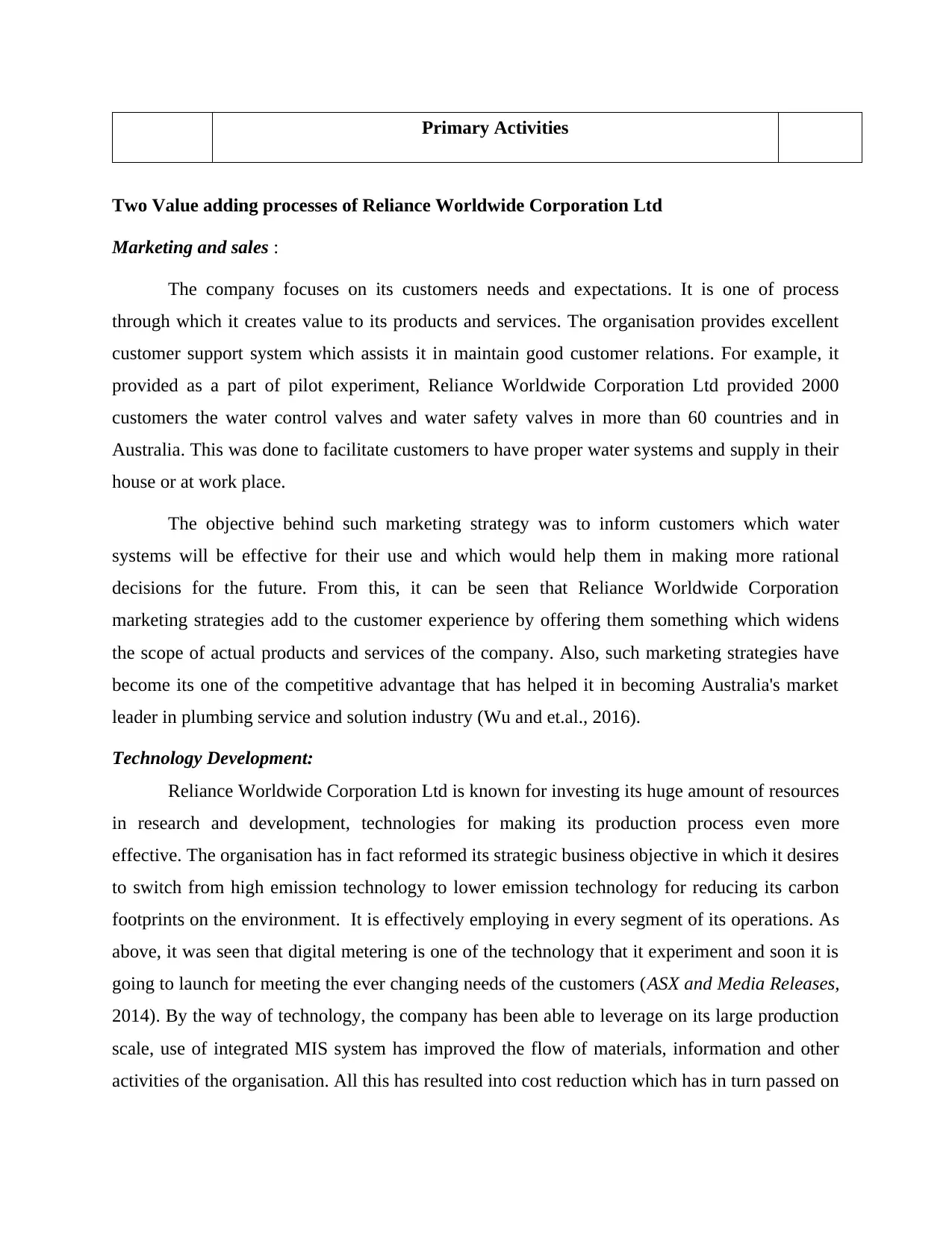
Primary Activities
Two Value adding processes of Reliance Worldwide Corporation Ltd
Marketing and sales :
The company focuses on its customers needs and expectations. It is one of process
through which it creates value to its products and services. The organisation provides excellent
customer support system which assists it in maintain good customer relations. For example, it
provided as a part of pilot experiment, Reliance Worldwide Corporation Ltd provided 2000
customers the water control valves and water safety valves in more than 60 countries and in
Australia. This was done to facilitate customers to have proper water systems and supply in their
house or at work place.
The objective behind such marketing strategy was to inform customers which water
systems will be effective for their use and which would help them in making more rational
decisions for the future. From this, it can be seen that Reliance Worldwide Corporation
marketing strategies add to the customer experience by offering them something which widens
the scope of actual products and services of the company. Also, such marketing strategies have
become its one of the competitive advantage that has helped it in becoming Australia's market
leader in plumbing service and solution industry (Wu and et.al., 2016).
Technology Development:
Reliance Worldwide Corporation Ltd is known for investing its huge amount of resources
in research and development, technologies for making its production process even more
effective. The organisation has in fact reformed its strategic business objective in which it desires
to switch from high emission technology to lower emission technology for reducing its carbon
footprints on the environment. It is effectively employing in every segment of its operations. As
above, it was seen that digital metering is one of the technology that it experiment and soon it is
going to launch for meeting the ever changing needs of the customers (ASX and Media Releases,
2014). By the way of technology, the company has been able to leverage on its large production
scale, use of integrated MIS system has improved the flow of materials, information and other
activities of the organisation. All this has resulted into cost reduction which has in turn passed on
Two Value adding processes of Reliance Worldwide Corporation Ltd
Marketing and sales :
The company focuses on its customers needs and expectations. It is one of process
through which it creates value to its products and services. The organisation provides excellent
customer support system which assists it in maintain good customer relations. For example, it
provided as a part of pilot experiment, Reliance Worldwide Corporation Ltd provided 2000
customers the water control valves and water safety valves in more than 60 countries and in
Australia. This was done to facilitate customers to have proper water systems and supply in their
house or at work place.
The objective behind such marketing strategy was to inform customers which water
systems will be effective for their use and which would help them in making more rational
decisions for the future. From this, it can be seen that Reliance Worldwide Corporation
marketing strategies add to the customer experience by offering them something which widens
the scope of actual products and services of the company. Also, such marketing strategies have
become its one of the competitive advantage that has helped it in becoming Australia's market
leader in plumbing service and solution industry (Wu and et.al., 2016).
Technology Development:
Reliance Worldwide Corporation Ltd is known for investing its huge amount of resources
in research and development, technologies for making its production process even more
effective. The organisation has in fact reformed its strategic business objective in which it desires
to switch from high emission technology to lower emission technology for reducing its carbon
footprints on the environment. It is effectively employing in every segment of its operations. As
above, it was seen that digital metering is one of the technology that it experiment and soon it is
going to launch for meeting the ever changing needs of the customers (ASX and Media Releases,
2014). By the way of technology, the company has been able to leverage on its large production
scale, use of integrated MIS system has improved the flow of materials, information and other
activities of the organisation. All this has resulted into cost reduction which has in turn passed on
Paraphrase This Document
Need a fresh take? Get an instant paraphrase of this document with our AI Paraphraser

to the customers in the form of best water supply and sustainable use of water. This is the reason
that Reliance Worldwide Corporation Ltd is the market leader and enjoys higher market
capitalisation which altogether has increased the wealth of shareholders over the years (Kehoe
and Mateer, 2015).
Comment
The information about Reliance Worldwide Corporation Ltd was useful in the sense that
research about the company's resources that has added to the value of products and services has
made the understanding of value chain concept even more clear. It was known that Reliance
Worldwide Corporation Ltd focuses on its marketing strategies, technological and innovation,
its ultra-tech infrastructure which has led to reach heights in the water control system and
plumbing service industry in Australia. Value chain model's main benefit is to improve the flow
of material, products, to provide competitive advantage by the way of cost and differentiation
approaches. Cost effectiveness is one of the objective of company since it believes in cost
leadership strategy for competing in the market. Such cost reduction in its operations has been
achieved by the company by employing technology through out the firm. These competitive
advantages are those capabilities of the company which are difficult to imitate by the
competitors. The altogether impact of competitive advantage of Reliance Worldwide
Corporation Ltd that it has the largest market share, has a greater profitability and greater
resources as compared to its rivals in the industry.
QUESTION 2
a.) Estimated allocation rates for fixed and variable overheads for current period
Allocation rate in management accounting is that standard numerical amount of
company's overhead which is applied to a department or unit or a specific activity. It is basically
a procedure of assigning costs of overhead to cost object. This is done for the purpose of
ascertaining proper cost of a job, batch or a product of a company. Also, it helps the managers in
ascertaining that which activity is consuming what amount of resources. This facilitates them in
their decision making for the future (Manello, Calabrese and Frigero, 2015).
Estimated for fixed and variable overhead for the current period is as follows :
Fixed overheads :
that Reliance Worldwide Corporation Ltd is the market leader and enjoys higher market
capitalisation which altogether has increased the wealth of shareholders over the years (Kehoe
and Mateer, 2015).
Comment
The information about Reliance Worldwide Corporation Ltd was useful in the sense that
research about the company's resources that has added to the value of products and services has
made the understanding of value chain concept even more clear. It was known that Reliance
Worldwide Corporation Ltd focuses on its marketing strategies, technological and innovation,
its ultra-tech infrastructure which has led to reach heights in the water control system and
plumbing service industry in Australia. Value chain model's main benefit is to improve the flow
of material, products, to provide competitive advantage by the way of cost and differentiation
approaches. Cost effectiveness is one of the objective of company since it believes in cost
leadership strategy for competing in the market. Such cost reduction in its operations has been
achieved by the company by employing technology through out the firm. These competitive
advantages are those capabilities of the company which are difficult to imitate by the
competitors. The altogether impact of competitive advantage of Reliance Worldwide
Corporation Ltd that it has the largest market share, has a greater profitability and greater
resources as compared to its rivals in the industry.
QUESTION 2
a.) Estimated allocation rates for fixed and variable overheads for current period
Allocation rate in management accounting is that standard numerical amount of
company's overhead which is applied to a department or unit or a specific activity. It is basically
a procedure of assigning costs of overhead to cost object. This is done for the purpose of
ascertaining proper cost of a job, batch or a product of a company. Also, it helps the managers in
ascertaining that which activity is consuming what amount of resources. This facilitates them in
their decision making for the future (Manello, Calabrese and Frigero, 2015).
Estimated for fixed and variable overhead for the current period is as follows :
Fixed overheads :

Manager's salary : 6250
Insurance & taxes : 900
Rent : 1000
Total fixed overhead cost = 8150
Allocation cost for fixed overheads = $ 8150/229 (Total number of hours)
= $ 35.58
Variable overheads per hour cost
Direct labour wages $5725/229 = 25
Indirect labour wages $1920/160 = 12
Utilities $100/229 = 0.43
Miscellaneous $1000/229 = 4.36
Allocation rate for variable overheads for current period = $41.36
Thus, the estimated allocation rates for fixed and variable overheads are $35.58 and $41.36
respectively for given period.
b.) Total overhead cost allocated to the Job 20 in October
Total number of hours for Job 20 : 10 hours
Total cost of Job 20 : $250
Calculation of variable fixed overhead cost for Job 20 :
Direct Labour wages : 5725*10/229 = 250
Indirect labour wages : 1920*10/160 = 120
Utilities : 100*10/229 =4.36
Miscellaneous : 1000*10/229 = 43.66
Total variable cost = $418.02
Fixed Overhead costs : $ 35.58 * 10 hours
= $ 355.8
Insurance & taxes : 900
Rent : 1000
Total fixed overhead cost = 8150
Allocation cost for fixed overheads = $ 8150/229 (Total number of hours)
= $ 35.58
Variable overheads per hour cost
Direct labour wages $5725/229 = 25
Indirect labour wages $1920/160 = 12
Utilities $100/229 = 0.43
Miscellaneous $1000/229 = 4.36
Allocation rate for variable overheads for current period = $41.36
Thus, the estimated allocation rates for fixed and variable overheads are $35.58 and $41.36
respectively for given period.
b.) Total overhead cost allocated to the Job 20 in October
Total number of hours for Job 20 : 10 hours
Total cost of Job 20 : $250
Calculation of variable fixed overhead cost for Job 20 :
Direct Labour wages : 5725*10/229 = 250
Indirect labour wages : 1920*10/160 = 120
Utilities : 100*10/229 =4.36
Miscellaneous : 1000*10/229 = 43.66
Total variable cost = $418.02
Fixed Overhead costs : $ 35.58 * 10 hours
= $ 355.8
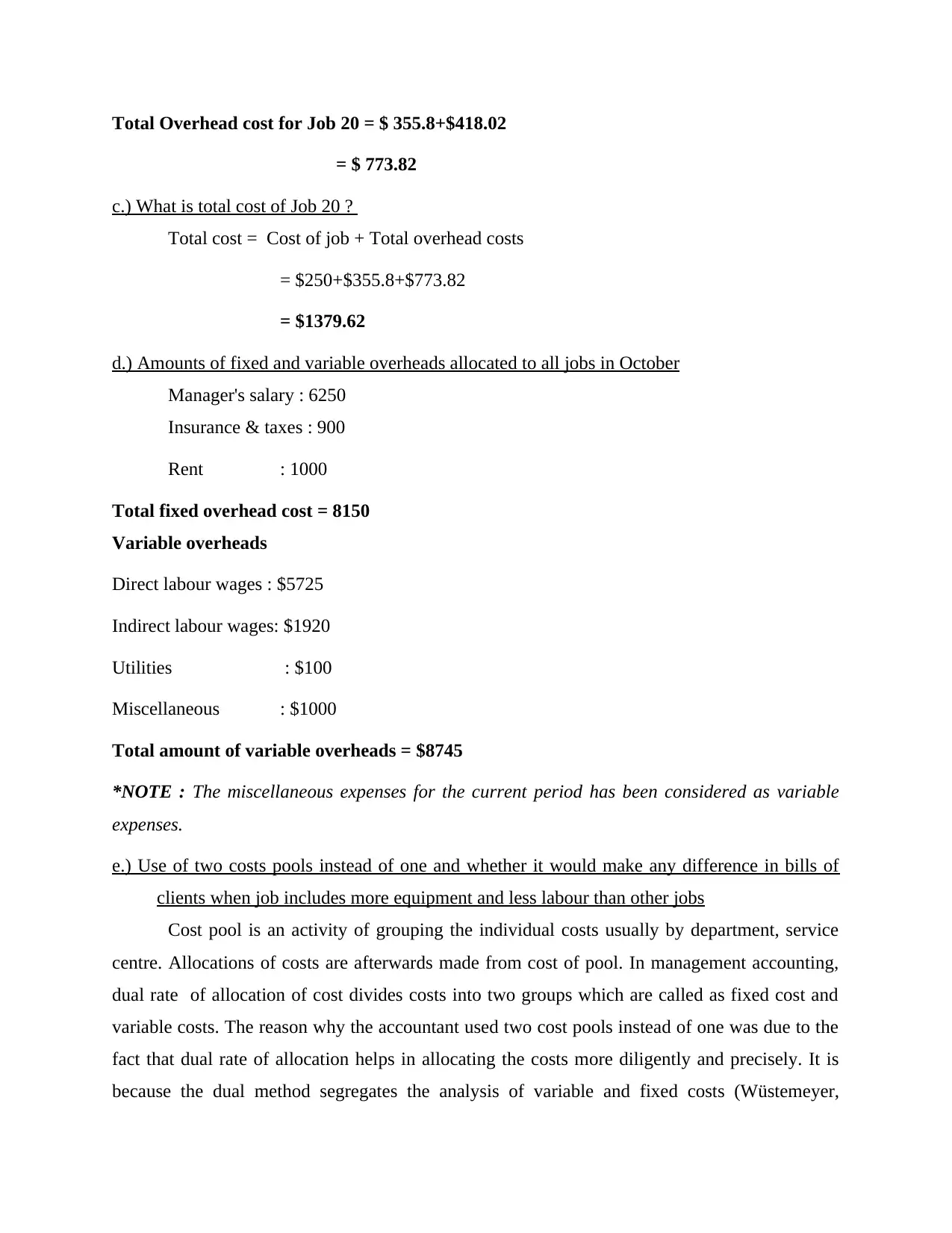
Total Overhead cost for Job 20 = $ 355.8+$418.02
= $ 773.82
c.) What is total cost of Job 20 ?
Total cost = Cost of job + Total overhead costs
= $250+$355.8+$773.82
= $1379.62
d.) Amounts of fixed and variable overheads allocated to all jobs in October
Manager's salary : 6250
Insurance & taxes : 900
Rent : 1000
Total fixed overhead cost = 8150
Variable overheads
Direct labour wages : $5725
Indirect labour wages: $1920
Utilities : $100
Miscellaneous : $1000
Total amount of variable overheads = $8745
*NOTE : The miscellaneous expenses for the current period has been considered as variable
expenses.
e.) Use of two costs pools instead of one and whether it would make any difference in bills of
clients when job includes more equipment and less labour than other jobs
Cost pool is an activity of grouping the individual costs usually by department, service
centre. Allocations of costs are afterwards made from cost of pool. In management accounting,
dual rate of allocation of cost divides costs into two groups which are called as fixed cost and
variable costs. The reason why the accountant used two cost pools instead of one was due to the
fact that dual rate of allocation helps in allocating the costs more diligently and precisely. It is
because the dual method segregates the analysis of variable and fixed costs (Wüstemeyer,
= $ 773.82
c.) What is total cost of Job 20 ?
Total cost = Cost of job + Total overhead costs
= $250+$355.8+$773.82
= $1379.62
d.) Amounts of fixed and variable overheads allocated to all jobs in October
Manager's salary : 6250
Insurance & taxes : 900
Rent : 1000
Total fixed overhead cost = 8150
Variable overheads
Direct labour wages : $5725
Indirect labour wages: $1920
Utilities : $100
Miscellaneous : $1000
Total amount of variable overheads = $8745
*NOTE : The miscellaneous expenses for the current period has been considered as variable
expenses.
e.) Use of two costs pools instead of one and whether it would make any difference in bills of
clients when job includes more equipment and less labour than other jobs
Cost pool is an activity of grouping the individual costs usually by department, service
centre. Allocations of costs are afterwards made from cost of pool. In management accounting,
dual rate of allocation of cost divides costs into two groups which are called as fixed cost and
variable costs. The reason why the accountant used two cost pools instead of one was due to the
fact that dual rate of allocation helps in allocating the costs more diligently and precisely. It is
because the dual method segregates the analysis of variable and fixed costs (Wüstemeyer,
Secure Best Marks with AI Grader
Need help grading? Try our AI Grader for instant feedback on your assignments.
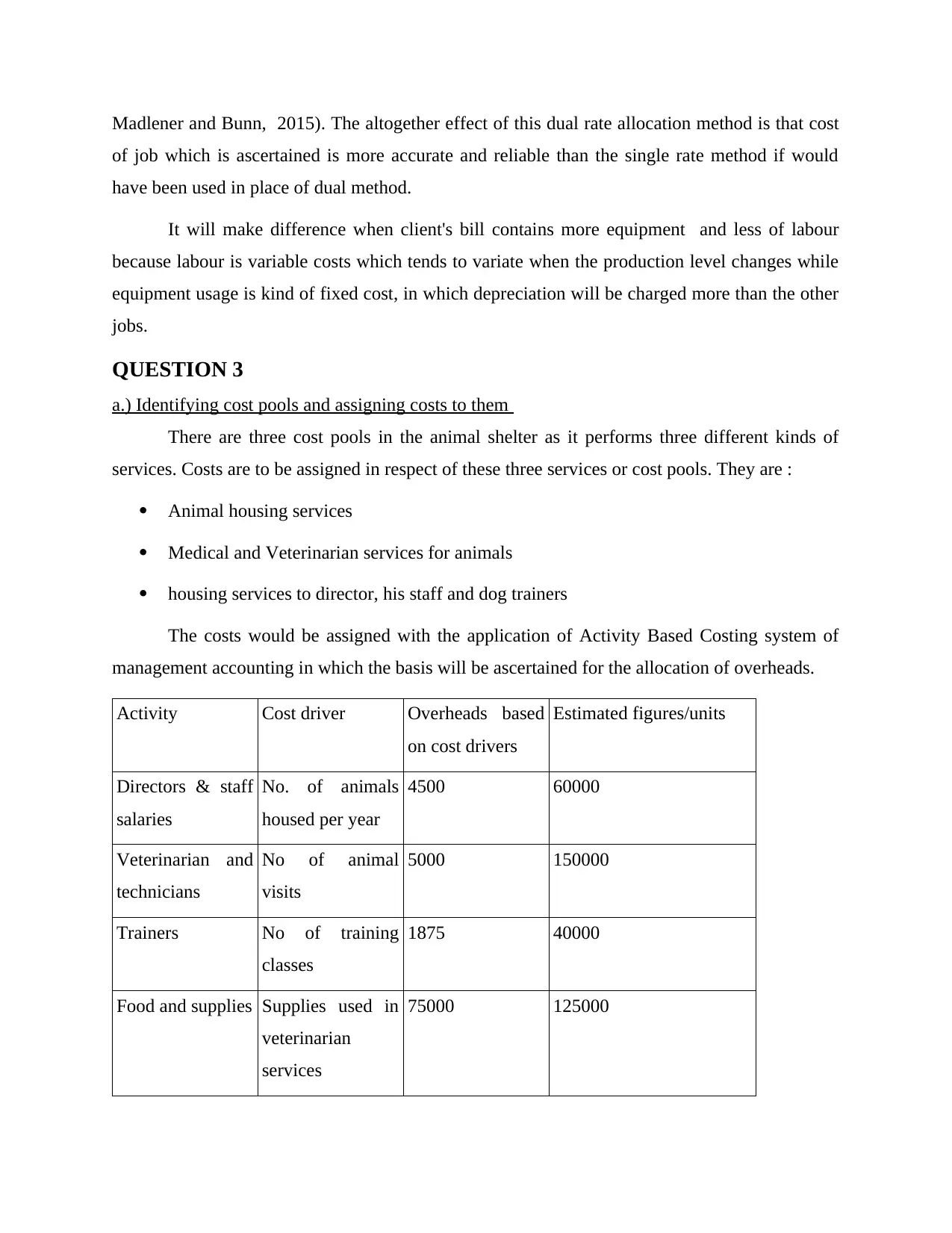
Madlener and Bunn, 2015). The altogether effect of this dual rate allocation method is that cost
of job which is ascertained is more accurate and reliable than the single rate method if would
have been used in place of dual method.
It will make difference when client's bill contains more equipment and less of labour
because labour is variable costs which tends to variate when the production level changes while
equipment usage is kind of fixed cost, in which depreciation will be charged more than the other
jobs.
QUESTION 3
a.) Identifying cost pools and assigning costs to them
There are three cost pools in the animal shelter as it performs three different kinds of
services. Costs are to be assigned in respect of these three services or cost pools. They are :
Animal housing services
Medical and Veterinarian services for animals
housing services to director, his staff and dog trainers
The costs would be assigned with the application of Activity Based Costing system of
management accounting in which the basis will be ascertained for the allocation of overheads.
Activity Cost driver Overheads based
on cost drivers
Estimated figures/units
Directors & staff
salaries
No. of animals
housed per year
4500 60000
Veterinarian and
technicians
No of animal
visits
5000 150000
Trainers No of training
classes
1875 40000
Food and supplies Supplies used in
veterinarian
services
75000 125000
of job which is ascertained is more accurate and reliable than the single rate method if would
have been used in place of dual method.
It will make difference when client's bill contains more equipment and less of labour
because labour is variable costs which tends to variate when the production level changes while
equipment usage is kind of fixed cost, in which depreciation will be charged more than the other
jobs.
QUESTION 3
a.) Identifying cost pools and assigning costs to them
There are three cost pools in the animal shelter as it performs three different kinds of
services. Costs are to be assigned in respect of these three services or cost pools. They are :
Animal housing services
Medical and Veterinarian services for animals
housing services to director, his staff and dog trainers
The costs would be assigned with the application of Activity Based Costing system of
management accounting in which the basis will be ascertained for the allocation of overheads.
Activity Cost driver Overheads based
on cost drivers
Estimated figures/units
Directors & staff
salaries
No. of animals
housed per year
4500 60000
Veterinarian and
technicians
No of animal
visits
5000 150000
Trainers No of training
classes
1875 40000
Food and supplies Supplies used in
veterinarian
services
75000 125000
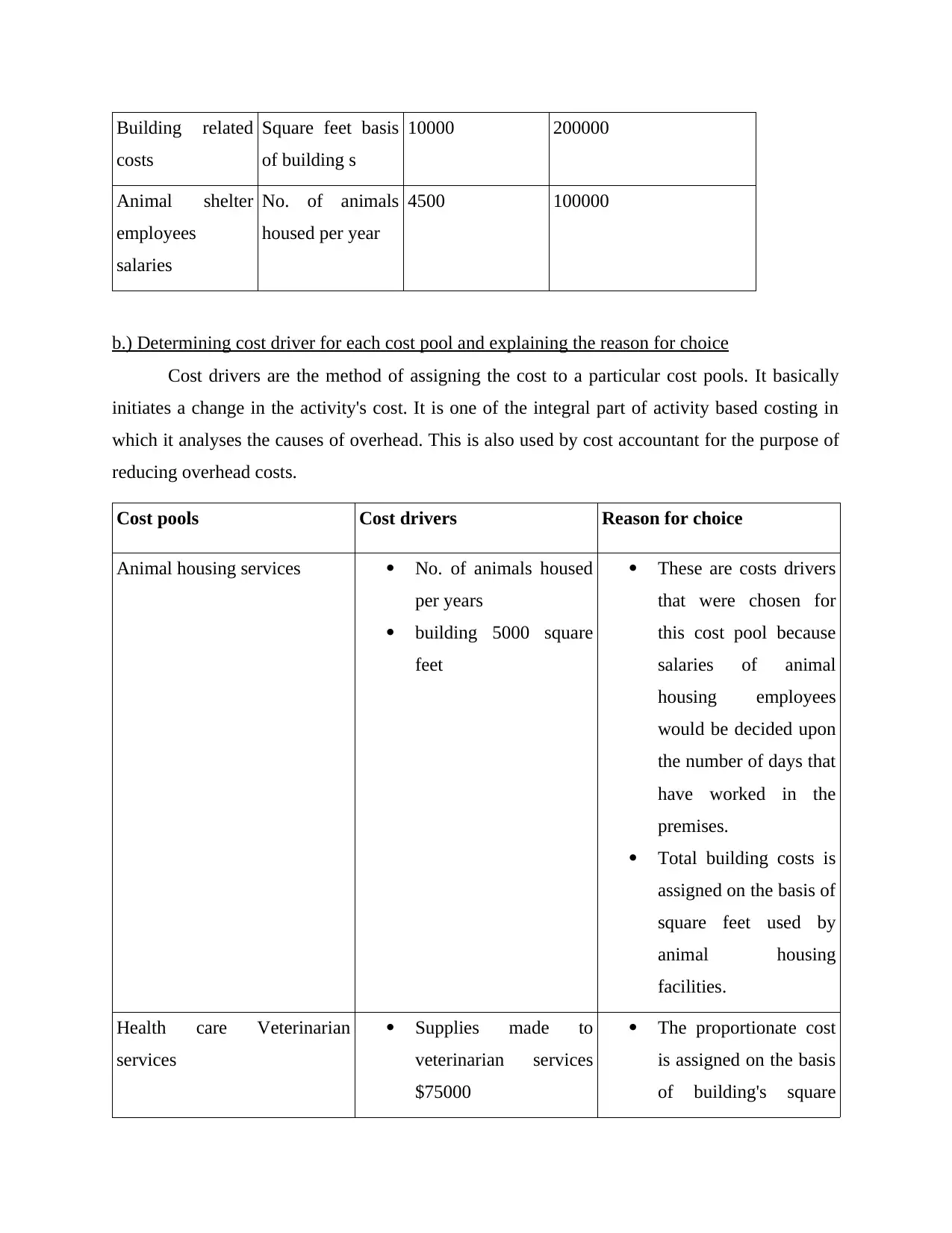
Building related
costs
Square feet basis
of building s
10000 200000
Animal shelter
employees
salaries
No. of animals
housed per year
4500 100000
b.) Determining cost driver for each cost pool and explaining the reason for choice
Cost drivers are the method of assigning the cost to a particular cost pools. It basically
initiates a change in the activity's cost. It is one of the integral part of activity based costing in
which it analyses the causes of overhead. This is also used by cost accountant for the purpose of
reducing overhead costs.
Cost pools Cost drivers Reason for choice
Animal housing services No. of animals housed
per years
building 5000 square
feet
These are costs drivers
that were chosen for
this cost pool because
salaries of animal
housing employees
would be decided upon
the number of days that
have worked in the
premises.
Total building costs is
assigned on the basis of
square feet used by
animal housing
facilities.
Health care Veterinarian
services
Supplies made to
veterinarian services
$75000
The proportionate cost
is assigned on the basis
of building's square
costs
Square feet basis
of building s
10000 200000
Animal shelter
employees
salaries
No. of animals
housed per year
4500 100000
b.) Determining cost driver for each cost pool and explaining the reason for choice
Cost drivers are the method of assigning the cost to a particular cost pools. It basically
initiates a change in the activity's cost. It is one of the integral part of activity based costing in
which it analyses the causes of overhead. This is also used by cost accountant for the purpose of
reducing overhead costs.
Cost pools Cost drivers Reason for choice
Animal housing services No. of animals housed
per years
building 5000 square
feet
These are costs drivers
that were chosen for
this cost pool because
salaries of animal
housing employees
would be decided upon
the number of days that
have worked in the
premises.
Total building costs is
assigned on the basis of
square feet used by
animal housing
facilities.
Health care Veterinarian
services
Supplies made to
veterinarian services
$75000
The proportionate cost
is assigned on the basis
of building's square
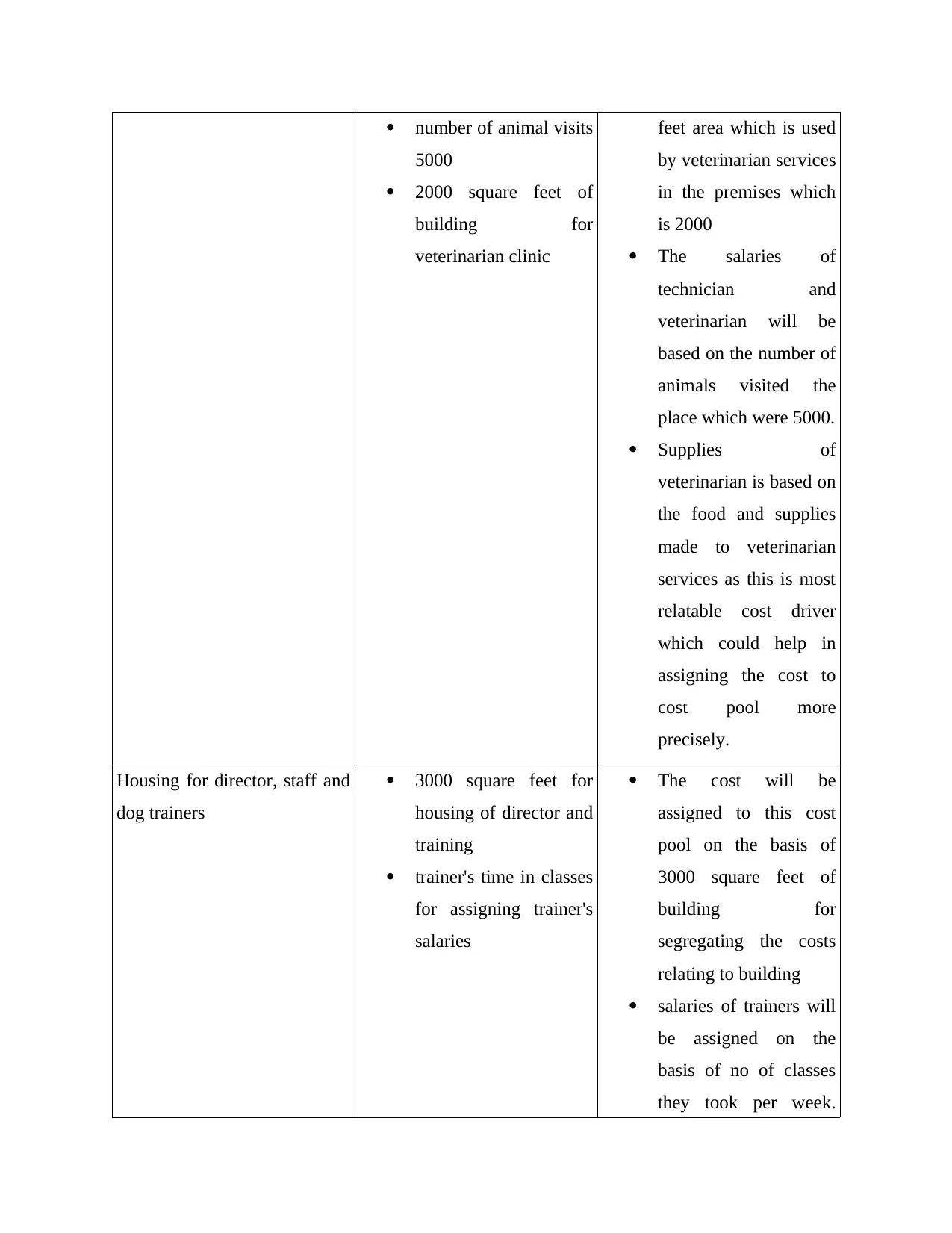
number of animal visits
5000
2000 square feet of
building for
veterinarian clinic
feet area which is used
by veterinarian services
in the premises which
is 2000
The salaries of
technician and
veterinarian will be
based on the number of
animals visited the
place which were 5000.
Supplies of
veterinarian is based on
the food and supplies
made to veterinarian
services as this is most
relatable cost driver
which could help in
assigning the cost to
cost pool more
precisely.
Housing for director, staff and
dog trainers
3000 square feet for
housing of director and
training
trainer's time in classes
for assigning trainer's
salaries
The cost will be
assigned to this cost
pool on the basis of
3000 square feet of
building for
segregating the costs
relating to building
salaries of trainers will
be assigned on the
basis of no of classes
they took per week.
5000
2000 square feet of
building for
veterinarian clinic
feet area which is used
by veterinarian services
in the premises which
is 2000
The salaries of
technician and
veterinarian will be
based on the number of
animals visited the
place which were 5000.
Supplies of
veterinarian is based on
the food and supplies
made to veterinarian
services as this is most
relatable cost driver
which could help in
assigning the cost to
cost pool more
precisely.
Housing for director, staff and
dog trainers
3000 square feet for
housing of director and
training
trainer's time in classes
for assigning trainer's
salaries
The cost will be
assigned to this cost
pool on the basis of
3000 square feet of
building for
segregating the costs
relating to building
salaries of trainers will
be assigned on the
basis of no of classes
they took per week.
Paraphrase This Document
Need a fresh take? Get an instant paraphrase of this document with our AI Paraphraser
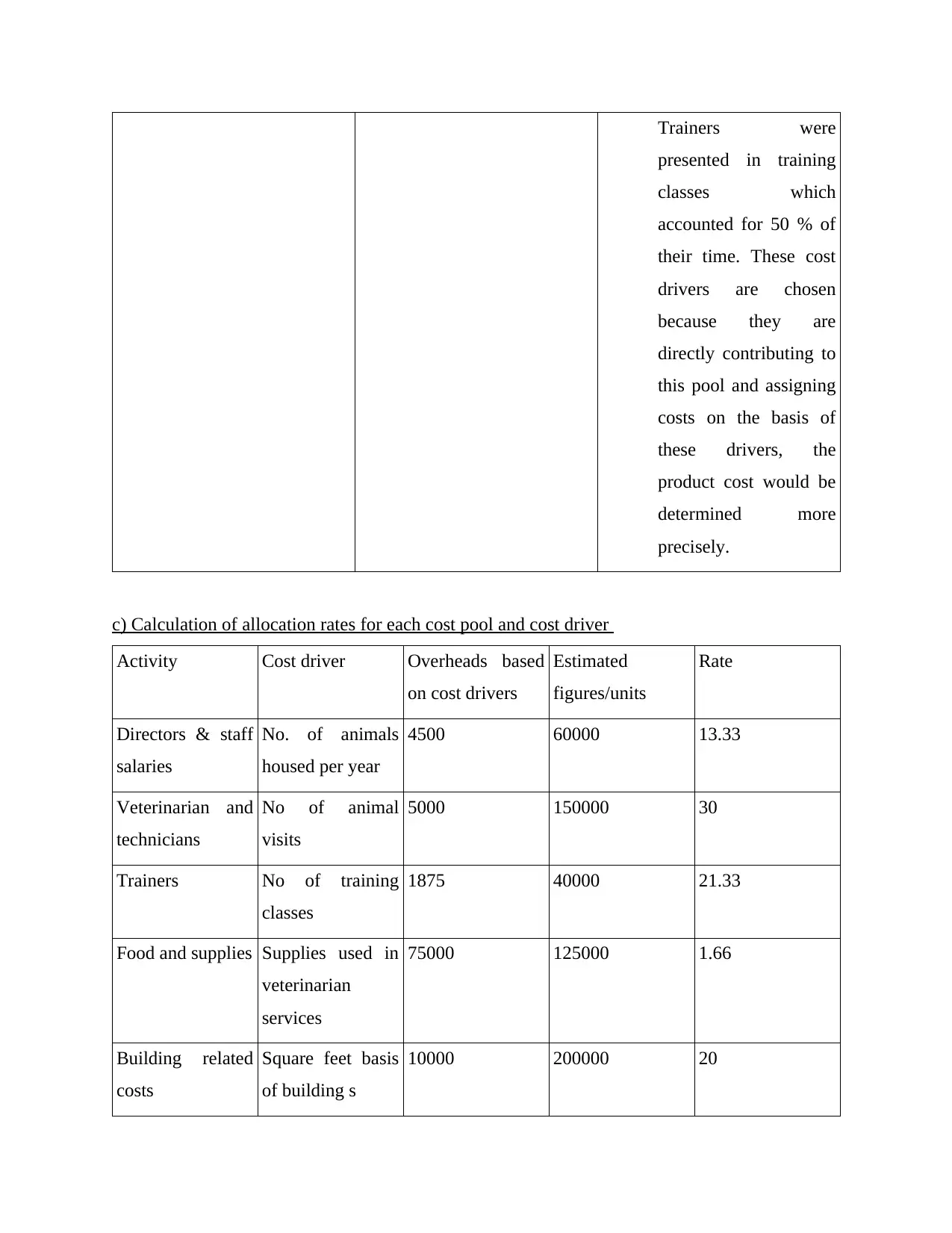
Trainers were
presented in training
classes which
accounted for 50 % of
their time. These cost
drivers are chosen
because they are
directly contributing to
this pool and assigning
costs on the basis of
these drivers, the
product cost would be
determined more
precisely.
c) Calculation of allocation rates for each cost pool and cost driver
Activity Cost driver Overheads based
on cost drivers
Estimated
figures/units
Rate
Directors & staff
salaries
No. of animals
housed per year
4500 60000 13.33
Veterinarian and
technicians
No of animal
visits
5000 150000 30
Trainers No of training
classes
1875 40000 21.33
Food and supplies Supplies used in
veterinarian
services
75000 125000 1.66
Building related
costs
Square feet basis
of building s
10000 200000 20
presented in training
classes which
accounted for 50 % of
their time. These cost
drivers are chosen
because they are
directly contributing to
this pool and assigning
costs on the basis of
these drivers, the
product cost would be
determined more
precisely.
c) Calculation of allocation rates for each cost pool and cost driver
Activity Cost driver Overheads based
on cost drivers
Estimated
figures/units
Rate
Directors & staff
salaries
No. of animals
housed per year
4500 60000 13.33
Veterinarian and
technicians
No of animal
visits
5000 150000 30
Trainers No of training
classes
1875 40000 21.33
Food and supplies Supplies used in
veterinarian
services
75000 125000 1.66
Building related
costs
Square feet basis
of building s
10000 200000 20

Animal shelter
employees
salaries
No. of animals
housed per year
4500 100000 22.22
CONCLUSION
From the above project report, it was concluded that management accounting is one of
the most significant tool for the business managers that assists them in their core business
decisions. This branch of accounting is mainly concerned with the systematic presentation of
cost related data of each of the activity of company through which proper decisions could be
taken. In the report, it was observed that Reliance Worldwide Corporation Ltd which is water
control and plumbing solutions company possess the competitive advantages in the form of
marketing and sales, high tech infrastructure and technology development. Value chain analysis
of the company was undertaken in the project report in which company's two value addition
processes were evaluated.
Further, there were calculations about the allocation of fixed and variable overheads in
the job costing which is one of the system of management accounting mainly concerned with the
ascertainment of cost of a particular project. The meaning of allocation of overheads was
understood in the present study that is the process of assigning costs that relates to cost object.
Lastly, activity based costing was applied in one segment of the report where costs were
allocated on the basis of their cost drivers.
employees
salaries
No. of animals
housed per year
4500 100000 22.22
CONCLUSION
From the above project report, it was concluded that management accounting is one of
the most significant tool for the business managers that assists them in their core business
decisions. This branch of accounting is mainly concerned with the systematic presentation of
cost related data of each of the activity of company through which proper decisions could be
taken. In the report, it was observed that Reliance Worldwide Corporation Ltd which is water
control and plumbing solutions company possess the competitive advantages in the form of
marketing and sales, high tech infrastructure and technology development. Value chain analysis
of the company was undertaken in the project report in which company's two value addition
processes were evaluated.
Further, there were calculations about the allocation of fixed and variable overheads in
the job costing which is one of the system of management accounting mainly concerned with the
ascertainment of cost of a particular project. The meaning of allocation of overheads was
understood in the present study that is the process of assigning costs that relates to cost object.
Lastly, activity based costing was applied in one segment of the report where costs were
allocated on the basis of their cost drivers.

REFERENCES
Books and Journals
D'heur, M., 2015. Sustainable Value Chain Management (p. P21). Springer International
Publishing: Imprint: Springer.
Gaviglio, A., Marescotti, M. and Demartini, E., 2018. The local value chain of hunted red deer
meat: a scenario analysis based on a northern Italian case study. Resources. 7(2). p.34.
Hammer, N. and Plugor, R., 2016. Near‐sourcing UK apparel: value chain restructuring,
productivity and the informal economy. Industrial Relations Journal. 47(5-6). pp.402-416.
Kehoe, K. and Mateer, J., 2015. The impact of digital technology on the distribution value chain
model of independent feature films in the UK. International journal on media management.
17(2). pp.93-108.
Lizano, V. R. and Vega, M. M., 2016. Costa Rican meat value chain description: Price
transmission as a tool. International Journal of Food and Agricultural Economics
(IJFAEC). 4(1128-2016-92099), p.91.
Manello, A., Calabrese, G. G. and Frigero, P., 2015. Technical efficiency and productivity
growth along the automotive value chain: evidence from Italy. Industrial and Corporate
Change. 25(2). pp.245-259.
Ugonna, C. U., Jolaoso, M. A. and Onwualu, A. P., 2015. Tomato value chain in Nigeria: Issues,
challenges and strategies. J. Sci. Res. Rep. 7(7). pp.501-515.
Van Hoang, V., 2015. Value Chain Analysis and Competitiveness Assessment of Da Xanh
Pomelo Sector in Ben Tre, Vietnam. Asian Social Science. 11(2). p.8.
Wu, L., and et.al., 2016. Smart supply chain management: a review and implications for future
research. The International Journal of Logistics Management. 27(2). pp.395-417.
Wüstemeyer, C., Madlener, R. and Bunn, D. W., 2015. A stakeholder analysis of divergent
supply-chain trends for the European onshore and offshore wind installations. Energy
Policy. 80. pp.36-44.
Online
Books and Journals
D'heur, M., 2015. Sustainable Value Chain Management (p. P21). Springer International
Publishing: Imprint: Springer.
Gaviglio, A., Marescotti, M. and Demartini, E., 2018. The local value chain of hunted red deer
meat: a scenario analysis based on a northern Italian case study. Resources. 7(2). p.34.
Hammer, N. and Plugor, R., 2016. Near‐sourcing UK apparel: value chain restructuring,
productivity and the informal economy. Industrial Relations Journal. 47(5-6). pp.402-416.
Kehoe, K. and Mateer, J., 2015. The impact of digital technology on the distribution value chain
model of independent feature films in the UK. International journal on media management.
17(2). pp.93-108.
Lizano, V. R. and Vega, M. M., 2016. Costa Rican meat value chain description: Price
transmission as a tool. International Journal of Food and Agricultural Economics
(IJFAEC). 4(1128-2016-92099), p.91.
Manello, A., Calabrese, G. G. and Frigero, P., 2015. Technical efficiency and productivity
growth along the automotive value chain: evidence from Italy. Industrial and Corporate
Change. 25(2). pp.245-259.
Ugonna, C. U., Jolaoso, M. A. and Onwualu, A. P., 2015. Tomato value chain in Nigeria: Issues,
challenges and strategies. J. Sci. Res. Rep. 7(7). pp.501-515.
Van Hoang, V., 2015. Value Chain Analysis and Competitiveness Assessment of Da Xanh
Pomelo Sector in Ben Tre, Vietnam. Asian Social Science. 11(2). p.8.
Wu, L., and et.al., 2016. Smart supply chain management: a review and implications for future
research. The International Journal of Logistics Management. 27(2). pp.395-417.
Wüstemeyer, C., Madlener, R. and Bunn, D. W., 2015. A stakeholder analysis of divergent
supply-chain trends for the European onshore and offshore wind installations. Energy
Policy. 80. pp.36-44.
Online
Secure Best Marks with AI Grader
Need help grading? Try our AI Grader for instant feedback on your assignments.
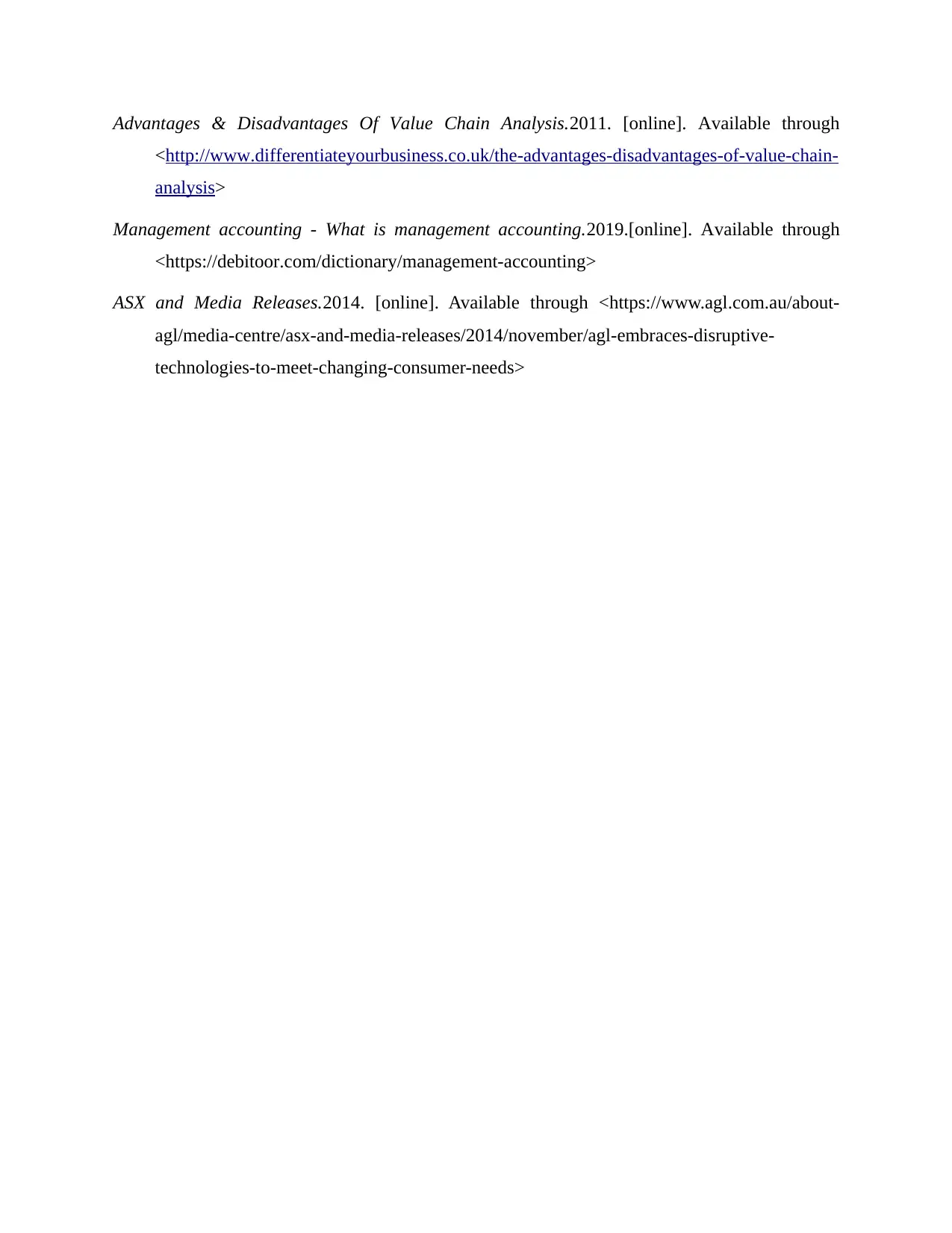
Advantages & Disadvantages Of Value Chain Analysis.2011. [online]. Available through
<http://www.differentiateyourbusiness.co.uk/the-advantages-disadvantages-of-value-chain-
analysis>
Management accounting - What is management accounting.2019.[online]. Available through
<https://debitoor.com/dictionary/management-accounting>
ASX and Media Releases.2014. [online]. Available through <https://www.agl.com.au/about-
agl/media-centre/asx-and-media-releases/2014/november/agl-embraces-disruptive-
technologies-to-meet-changing-consumer-needs>
<http://www.differentiateyourbusiness.co.uk/the-advantages-disadvantages-of-value-chain-
analysis>
Management accounting - What is management accounting.2019.[online]. Available through
<https://debitoor.com/dictionary/management-accounting>
ASX and Media Releases.2014. [online]. Available through <https://www.agl.com.au/about-
agl/media-centre/asx-and-media-releases/2014/november/agl-embraces-disruptive-
technologies-to-meet-changing-consumer-needs>
1 out of 17
Related Documents
Your All-in-One AI-Powered Toolkit for Academic Success.
+13062052269
info@desklib.com
Available 24*7 on WhatsApp / Email
![[object Object]](/_next/static/media/star-bottom.7253800d.svg)
Unlock your academic potential
© 2024 | Zucol Services PVT LTD | All rights reserved.





